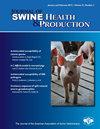评估自然计划暴露方案对母猪轮状病毒脱落模式及其对乳猪的影响
IF 0.7
4区 农林科学
Q3 Agricultural and Biological Sciences
引用次数: 0
摘要
目的:本研究的目的是确定自然计划暴露(NPE)给药后母猪轮状病毒A(RVA)、轮状病毒B(RVB)和轮状病毒C(RVC)脱落的模式,并评估其对仔猪断奶体重、断奶前死亡率和RV脱落的影响。材料和方法:将70头妊娠母猪随机分为4组。第1组在出生前5、4和3周给予NPE(WPF);第2组为5和3 WPF;而第3组仅为5WPF。第4组(对照组)未接受任何NPE。对46头母猪和窝仔(5头仔猪/窝)的样本进行了12次取样测试。从24小时龄到6周龄,每周对仔猪进行取样,并通过定量逆转录聚合酶链式反应检测RVA、RVB和RVC。结果:与较少或不施用NPE相比,施用3次NPE的母猪所产仔猪的断奶体重显著提高。无论治疗组如何,在产仔室都能很好地控制仔猪RVA和RVB的脱落,但早在1周大时就观察到RVC。这项研究是在一个农场上进行的,应该根据农场和系统的变化来仔细解释结果。影响:NPE对金边债券预售的三次管理为生产商带来了宝贵的生产和经济效益。RVA、RVB和RVC的循环模式似乎是相关的;一方的干预措施对另一方有价值。本文章由计算机程序翻译,如有差异,请以英文原文为准。
Evaluating natural planned exposure protocols on rotavirus shedding patterns in gilts and the impact on their suckling pigs
Objective: The objectives of this study were to determine the pattern of rotavirus A (RVA), rotavirus B (RVB), and rotavirus C (RVC) shedding in gilts after natural planned exposure (NPE) administration and assess the effects on piglet weaning weight, preweaning mortality, and RV shedding. Materials and methods: A total of 70 pregnant gilts were enrolled and allocated into 4 groups. Group 1 was given NPE at 5, 4, and 3 weeks prefarrowing (WPF); Group 2 at 5 and 3 WPF; and Group 3 at 5 WPF only. Group 4 (control group) did not receive any NPE. Samples from 46 gilts and litters (5 piglets/litter) were tested at 12 sample times. Piglets were sampled weekly from 24 hours of age until 6 weeks of age and tested by quantitative reverse transcriptase-polymerase chain reaction for RVA, RVB, and RVC. Results: There was a significant improvement in weaning weight of piglets born to gilts that received 3 NPE administrations compared to fewer or no NPE administrations. Shedding of RVA and RVB from piglets were well controlled in the farrowing room regardless of treatment group, but RVC was observed as early as 1 week old. This study was conducted on a single farm, and the results should be carefully interpreted with knowledge of variations in farms and systems. Implications: Three administrations of NPE to gilts prefarrowing had valuable production and economic benefits for the producer. Circulation patterns of RVA, RVB, and RVC appear to correlate; interventions for one have value against the others.
求助全文
通过发布文献求助,成功后即可免费获取论文全文。
去求助
来源期刊
CiteScore
1.80
自引率
0.00%
发文量
29
审稿时长
>36 weeks
期刊介绍:
The Journal of Swine Health & Production (JSHAP) is an open-access and peer-reviewed journal published by the American Association of Swine Veterinarians (AASV) since 1993. The aim of the journal is the timely publication of peer-reviewed papers with a scope that encompasses the many domains of applied swine health and production, including the diagnosis, treatment, management, prevention and eradication of swine diseases, welfare & behavior, nutrition, public health, epidemiology, food safety, biosecurity, pharmaceuticals, antimicrobial use and resistance, reproduction, growth, systems flow, economics, and facility design. The journal provides a platform for researchers, veterinary practitioners, academics, and students to share their work with an international audience. The journal publishes information that contains an applied and practical focus and presents scientific information that is accessible to the busy veterinary practitioner as well as to the research and academic community. Hence, manuscripts with an applied focus are considered for publication, and the journal publishes original research, brief communications, case reports/series, literature reviews, commentaries, diagnostic notes, production tools, and practice tips. All manuscripts submitted to the Journal of Swine Health & Production are peer-reviewed.

 求助内容:
求助内容: 应助结果提醒方式:
应助结果提醒方式:


